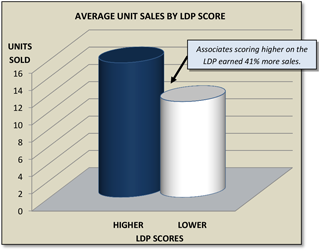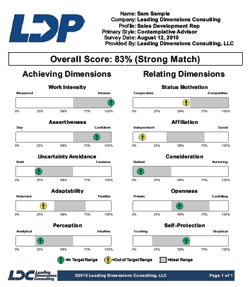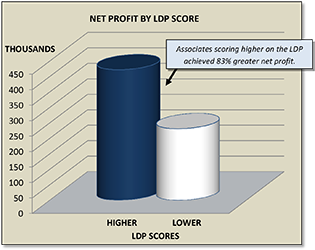Using the LDP in recruiting and selection is made possible by a comprehensive suite of user-friendly reports. Recruiters, managers, HR professionals and business owners use these reports to attract, select, and develop high performers in a variety of occupations. A few examples are highlighted in the following case studies:
Recruiting
Building a high-quality talent pipeline can be a daunting task for recruiters, especially when placing call center associates. With average turnover in excess of 40% within the industry, employers face an urgent and costly challenge. While online job posting services can provide access to job seekers, employers have little time to wade through the volume of responses they receive from each post. Facing such a challenge, one company developed an innovative approach using the LDP to recruit and prioritize its applicant pool for Call Centre Associate positions. The employer began by developing a profile of the ideal Call Centre Associate by administering the LDP to a sample of its current employees. Based on the results, a Score Card was developed to compare job seekers' LDP scores to the ideal profile of the call center's top performers.

Recruiters posted announcements on regional online job boards, directing job seekers to complete the LDP via a link within the announcement. To attract interest, the posting offered a free Personal Style Report (generated by the LDP) to participants. As soon as each job seeker completed the LDP, recruiters were alerted by email, allowing contact to be made within minutes of the job seeker's initial interest. All job seekers received a copy of their LDP Personal Style Report via email, with the most promising candidates being offered an initial interview with the employer. By leveraging the LDP in this way, recruiters received over 1,000 responses, already stack-ranked and prioritized according to the job seeker's match against the ideal profile.
Within just weeks of implementing the LDP for recruiting, the employer discovered that new hires matching the LDP profile achieved 41% higher performance than those hired despite lower LDP scores.
The result: fewer interviews, more quality hires, and higher productivity.
Sales force Selection
Even with an effective recruiting strategy, the process of screening candidates can present quite a challenge for employers. With high unemployment and few openings, it seems all too common for job seekers to provide a dizzying array of information, much of which is handcrafted to leave the most favorable impression on a prospective employer. This is especially true among candidates for sales positions, where the ability to "sell one's self" may be a key factor. For many employers struggling to navigate through the fog of exaggerated resumes and glowing references, the LDP provides an objective selection tool with the validity and job-relatedness that will keep the employer out of harms' way.

With a steep learning curve and intense competition in the industry, a professional employer organization (PEO) looked to the LDP's Work Style Report to help them screen candidates for openings within its sales development team. The PEO developed a benchmark of its highest performers based on the LDP's ten personality dimensions, and then evaluated performance differences between those who matched the LDP profile and those who earned lower scores.
The result: on average, sales reps closely matching the LDP profile closed 19% more sales than those who were a lesser match to the profile.
In yet another example, a timeshare company implemented the LDP within an existing selection process for its on-property sales representatives. The employer recognized that the most successful reps were those who could quickly assess a buyer's interest and qualification level, and then adapt their sales presentation in order to answer potential objections and close the deal. Not a job for just anyone, and yet the employer was inundated with applications from those claiming to have just what it takes to be successful in sales.
The company used the LDP's four-style grid to identify candidates with the drive and intensity to reach performance targets, the assertiveness to control the sales process, as well as the sociability required to promote positive customer relations.
The result: sales reps who matched the LDP profile earned 59% higher net sales than their lower-scoring peers. Not only did higher LDP scores lead to increased sales, the higher scoring reps were also more efficient. In fact, higher scoring reps sold over $2,000 more per prospect - 79% more than their peers.
Management & Supervisory Positions
As noted earlier, small businesses are most impacted when openings remain unfilled or when new hires struggle to work through the learning curve for a position. In a workplace where employees already wear multiple hats, the impact of a hiring mistake can reach every corner of the organization. This is especially true within managerial positions, where poor performance can erode teamwork and hamper productivity.

Realizing that an inconsistent or ineffective hiring process means lost opportunity for its franchisees, a multinational staffing company developed LDP profiles for a variety of roles within its locations, including General Manager. A key role within the franchise, the General Manager oversees administrative and operational functions, manages the customer service and sales activities within the territory, while also directing the financial and compliance activities of the office. Often faced with diverse and challenging responsibilities, the most successful General Managers share certain key characteristics found within the LDP's ten dimensions.
After developing an LDP profile for the General Manager role, the company found that those matching the profile achieving higher performance in every category. Most notably, higher scoring managers:
- Were awarded 148% higher performance ratings
- Achieved 83% higher net profit
- Maintained 19% lower accounts receivable
- Gained 24% more new clients
Within each aspect of their work, operational, sales and financial, General Managers who more closely matched the LDP profile achieved higher performance (in both subjective and objective categories).
The result: higher performing General Managers develop higher performing teams, allowing the company to achieve more with less.
Executive Placement
Although personality assessments like the LDP are often utilized within entry-level and high volume selection programs, they have been used to assess senior leadership candidates for more than a century. While technology may have changed the delivery method over the years, the basic premise is still the same: executive-level placement requires an exhaustive review of the candidate's portfolio, including leadership style and related behavioral dimensions.
The LDP provides just such a review, allowing search committees and selection professionals to anticipate how an individual will respond within a leadership role. In addition, the LDP's Leading Style Guide provides an excellent follow-up resource, allowing a newly placed leader to further develop their style by leveraging strengths identified via the LDP.